

Emergency Management. ICS Resource Center. Incident Command System. Incident Command System (ICS) Overview The Incident Command System (ICS) is a standardized, on-scene, all-hazards incident management approach that: Allows for the integration of facilities, equipment, personnel, procedures and communications operating within a common organizational structure.Enables a coordinated response among various jurisdictions and functional agencies, both public and private.Establishes common processes for planning and managing resources. ICS is flexible and can be used for incidents of any type, scope and complexity. ICS allows its users to adopt an integrated organizational structure to match the complexities and demands of single or multiple incidents. ICS is used by all levels of government—federal, state, tribal and local—as well as by many nongovernmental organizations and the private sector.
Click on this link to review the ICS management characteristics. ICS Core Competencies Incident Management Teams Type 3 Incident Management Team. FAQs Q. Q. Q. Q. A: Yes. NIMS Training. NIMS Training Homeland Security Presidential Directive - 5 (HSPD-5): Management of Domestic Incidents enhances the ability of the United States to manage domestic incidents by establishing a single, comprehensive national incident management system.
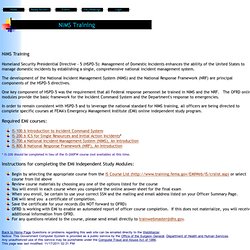
The development of the National Incident Management System (NIMS) and the National Response Framework (NRF) are principal components of the HSPD-5 directives. One key component of HSPD-5 was the requirement that all Federal response personnel be trained in NIMS and the NRF. The OFRD online modules provide the basic framework for the Incident Command System and the Department's response to emergencies. In order to remain consistent with HSPD-5 and to leverage the national standard for NIMS training, all officers are being directed to complete specific courses at FEMA's Emergency Management Institute (EMI) online independent study program.
Required EMI courses: Instructions for completing the EMI Independent Study Modules: Training - NIMS. While most emergency situations are handled successfully at the local level, larger incidents may require added coordination and response assistance from other jurisdictions, or state or federal agencies.
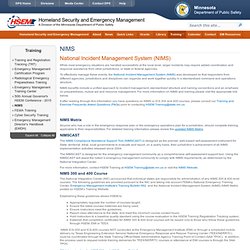
To effectively manage these events, the National Incident Management System (NIMS) was developed so that responders from different agencies, jurisdictions and disciplines can organize and work together quickly in a standardized command and operations structure. NIMS benefits include a unified approach to incident management; standardized structure and naming conventions and an emphasis on preparedness, mutual aid and resource management. For more information on NIMS and training please visit the appropriate link below. NIMS Matrix Anyone who has a role in the emergency response plan or the emergency operations plan for a jurisdiction, should complete training applicable to their responsibilities. NIMS 300 and 400 Course Establishing these guidelines allows HSEM to: Incident Command System. ICS basic organization chart (ICS-100 level depicted) The Incident Command System (ICS) is "a systematic tool used for the command, control, and coordination of emergency response" according to the United States Federal Highway Administration.[1] A more detailed definition of an ICS according to the United States Center for Excellence in Disaster Management & Humanitarian Assistance is "a set of personnel, policies, procedures, facilities, and equipment, integrated into a common organizational structure designed to improve emergency response operations of all types and complexities.
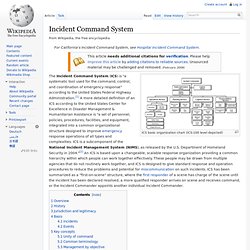
ICS is a subcomponent of the National Incident Management System (NIMS), as released by the U.S. Department of Homeland Security in 2004. "[2] An ICS is based upon a changeable, scalable response organization providing a common hierarchy within which people can work together effectively. Overview[edit] National Incident Management System. NIMS redirects here.
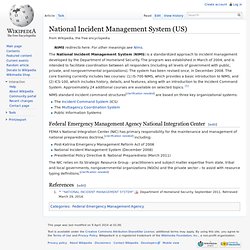
For other meanings see Nims. National Incident Management System (NIMS) National Incident Management System (NIMS) The National Incident Management System (NIMS) provides a systematic, proactive approach to guide departments and agencies at all levels of government, nongovernmental organizations, and the private sector to work seamlessly to prevent, protect against, respond to, recover from, and mitigate the effects of incidents, regardless of cause, size, location, or complexity, in order to reduce the loss of life and property and harm to the environment.
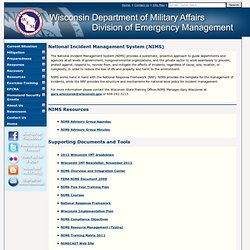
NIMS works hand in hand with the National Response Framework (NRF). NIMS provides the template for the management of incidents, while the NRF provides the structure and mechanisms for national-level policy for incident management. For more information please contact the Wisconsin State Training Officer/NIMS Manager, Gary Wieczorek at gary.wieczorek@wisconsin.gov or 608.242.3213. Independent Study (IS) - NIMS Courses. National Integration Center.
NIMS and National Preparedness Click here to subscribe to the NIMS mailing list The National Incident Management System (NIMS) identifies concepts and principles that answer how to manage emergencies from preparedness to recovery regardless of their cause, size, location or complexity.

NIMS provides a consistent, nationwide approach and vocabulary for multiple agencies or jurisdictions to work together to build, sustain and deliver the core capabilities needed to achieve a secure and resilient nation. Consistent implementation of NIMS provides a solid foundation across jurisdictions and disciplines to ensure effective and integrated preparedness, planning and response. The National Preparedness Goal is a secure and resilient nation with the capabilities required across the whole community to prevent, protect against, mitigate, respond to and recover from the threats and hazards that pose the greatest risk. National Integration Center Guidance Delivery and Whole Community Engagement.